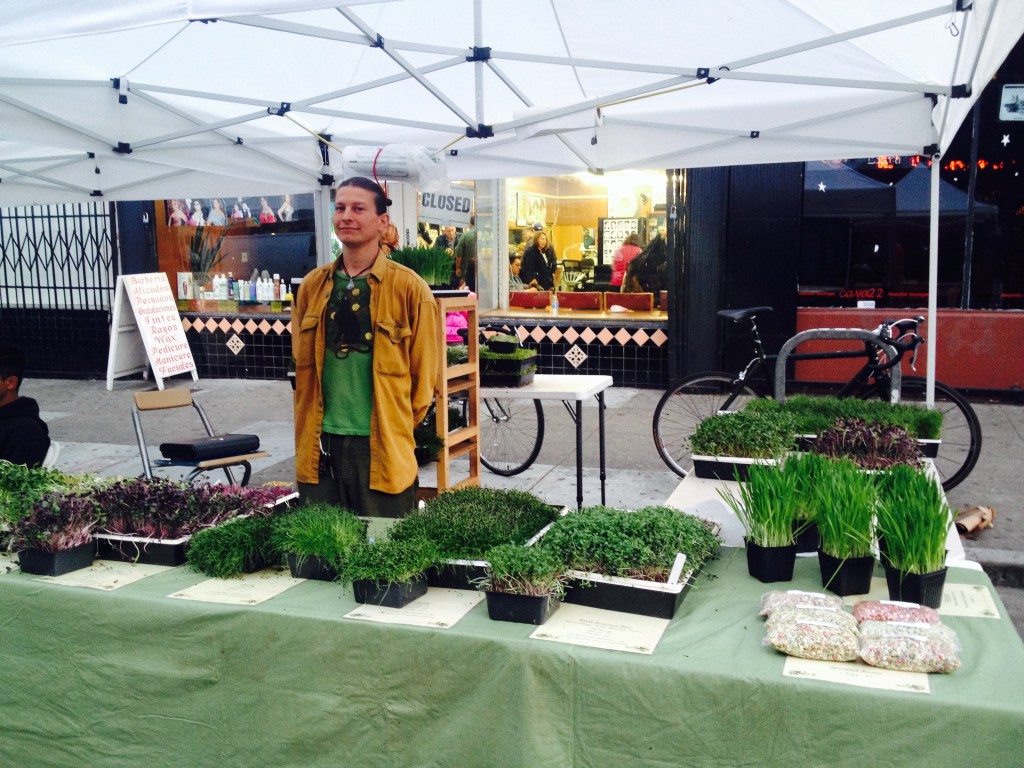
At the Twin Girls Farms booth, kids circle the cherry samples, grabbing fistfuls of the fruit and grinning. One jumps up and down. “Yay cherries!” he smiles. The booth’s proprietor Jimmy Egoian smiles too. After a few weeks away from Mission Community Market, Twin Girls has just turned the corner from winter season. Their tables are a testament to the warmer weather, and favorites, like yellow and white peaches, are piled high; there are signs pointing to new gems, too––pluots, donut white peaches, apriums, and loquats. I spoke to Jimmy about Twin Girls’ mission, what makes a good fruit, and how to tell the difference between a pluot and an aprium.
Twin Girls is not a superficial farm. “We don’t care what fruits look like,” Jimmy says. “If it eats good, it is good.” In fact, Jimmy explains that bad looking fruits are better tasting. “If it’s cracked,” he says, “it is ten times better.” The cracked fruits have a higher sugar content than their smooth-surfaced companions. When the fruits are growing, that sugar content causes the insides to grow faster than the outside, leading to skins that split and then re-heal.

Scarred (and sweet!) nectarines at Twin Girls Farm’s booth.
It’s clear that shoppers respond to Twin Girls’ commitment to eating. Today, visitors are reaching for the new editions to Twin Girls’ table: apriums and pluots. Can’t tell the difference? Jimmy let me in on the secret––“apriums,” Jimmy notes, “are just backwards pluots.” What he means is that both fruits are combinations of apricots and plums, but they differ in composition; while pluots are about 75% plum and 25% apricot, apriums are the opposite.

Apriums, like any other fruit, come in a variety of strains. The best one, flavorellas, are also the most rare––Jimmy tells me that farms can only grow about 10 to each tree. In comparison, the aprium strain that Twin Girls has on it’s tables, tasty rich apriums, grows 200 aprium fruits on each tree.

Jimmy Egoian, the proprietor of the Twin Girls Farm stall at MCM
Another unique strain of stone fruit that has become a family favorite is the donut peach. Twin Girls has white donut peaches, and when Jimmy hands me one to taste, its sweetness is so concentrated I feel like I’m eating candy. That isn’t because of the donut shape, though, this donut strain just has more sugar. But the distinctive shape is a favorite with kids, who find the oblong shape easy to hold. Adults, too, flock to the donut peaches––perhaps reminiscing about their own childhood.
Yellow peaches are more acidic than their pale counterparts, which gives them that distinctive “tang” that works well in pies and on the grill.
And what is the taste difference between a white and yellow peach? White peaches, distinguishable by their paler, pink skins, are sweeter, and thus more easily bruised. Yellow peaches are more acidic than their pale counterparts, which gives them that distinctive “tang” that works well in pies and on the grill. Try white peaches on their own, with salsas or ceviche, or in drinks.

White peaches are sweeter and less acidic than yellow.
One more fruit that I’m interested in is grown in bunches on thick, brown stems. “That’s a loquat,” Jimmy notes, “it’s an old type of fruit.” It may be old, but its introduction to shoppers at Mission Community Market is recent. Loquats, which are ripe in the late winter or early spring, and may not be at the market for much longer, are sweetest when they are soft and orange.

When I bite into the loquat that Jimmy hands me, I’m reminded of a lychee. Try loquats in jelly, compote, or even wine.
The farm started with yellow peaches a few weeks ago, which Jimmy tells me is about “10 days earlier than early.” But “no matter what,” he continues, “from year to year everyone wants a yellow peach.” To determine when peaches, and other stone fruits like them, will become ripe, farmers look at the “bloom” of the plants. When the bloom comes in farmers can determine whether their crops will be early, on time, or late. Early doesn’t necessarily mean better; Twin Girls’ peaches may have grown premature due to a dry winter. But Jimmy cautions against drought fear-mongering: “we’ve been dealing with little water for 6 or 7 years,” he says.
“The perfect fruit is never the best fruit.”
Along with the crop time, deficient water can affect the shape of the fruit. Lopsided fruits are one result of a drought; when the pits, or stones, of a fruit are not sufficiently hydrated, they may be unable to grow evenly. But other imperfections, are not a problem for Twin Girls’––for this farm, it’s all about the taste. “That’s what’s going to bring people back,” Jimmy says, handing me a slice of aprium. It’s bruised, but very sweet. “The perfect fruit,” he continues, “is never the best fruit.”















